Samsonite International Bundle
How Does Samsonite International Thrive in a Changing World?
Samsonite International, a titan in the travel goods sector, boasts a remarkable 25% market share, solidifying its leadership. But how does this luggage company maintain its competitive edge? This article explores the inner workings of Samsonite, revealing the strategies behind its enduring success and global presence.
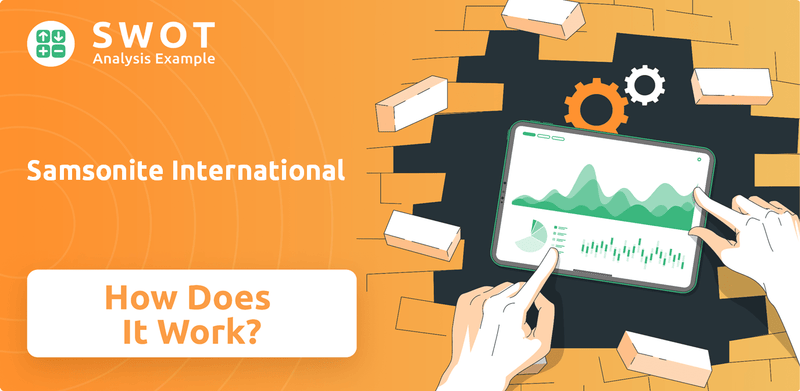
With 2024 sales figures showcasing resilience, and a strategic brand strategy, understanding the Samsonite International SWOT Analysis is crucial. This deep dive will dissect Samsonite's business model, from its innovative product design and manufacturing to its diverse revenue streams and global distribution channels. Explore the factors that contribute to Samsonite's financial performance and its ability to adapt to evolving consumer demands within the travel industry.
What Are the Key Operations Driving Samsonite International’s Success?
Samsonite International, a leading luggage company, operates globally by designing, manufacturing, sourcing, and distributing a wide array of travel-related products. This includes luggage, business and computer bags, outdoor and casual bags, and travel accessories. The company's brand strategy is centered around a multi-brand approach, catering to diverse customer segments and price points.
The company's core operations are built on a largely asset-light business model, with most products manufactured by third-party vendors. Samsonite International leverages its relationships with approximately 100 vendors to ensure favorable sourcing terms. Its extensive distribution network includes a significant number of company-operated retail stores and a robust presence through franchisee-operated stores and multi-brand retail outlets.
Samsonite's value proposition is centered on delivering durable, high-quality products across a diverse range of options, supported by strong brand recognition and a commitment to sustainability. The company's focus on product innovation and marketing, coupled with its multi-brand portfolio, allows it to meet the varied needs of travelers worldwide and maintain a competitive edge in the travel industry.
Samsonite relies on a network of around 100 vendors for manufacturing its products, utilizing an asset-light model. This approach enables the company to manage costs efficiently and focus on brand development and distribution. This sourcing strategy is crucial for maintaining competitive pricing and ensuring product quality.
The company's distribution network includes a vast global retail presence. As of December 31, 2024, Samsonite operated 1,119 company-owned retail stores, expanding from 1,052 stores as of December 31, 2023. Franchisee-operated stores and multi-brand retail outlets also play a significant role in reaching consumers worldwide.
Samsonite invests significantly in marketing, allocating around 7% of its revenue in 2024 to promote its brands and products. This investment supports brand recognition and customer engagement. The multi-brand strategy allows Samsonite to target different customer segments effectively.
Samsonite is committed to sustainability, with approximately 40% of its net sales in 2024 coming from products that include some recycled content, up from 34% in 2023. This focus on sustainability enhances its brand image and appeals to environmentally conscious consumers.
Samsonite offers durable, high-quality products and a wide variety of options to meet diverse customer needs. The company's strong brand recognition and global presence ensure accessibility and trust among consumers. These factors contribute to Samsonite's competitive advantage in the market.
- Durable and High-Quality Products
- Diverse Product Range
- Strong Brand Recognition
- Global Accessibility
Samsonite International SWOT Analysis
- Complete SWOT Breakdown
- Fully Customizable
- Editable in Excel & Word
- Professional Formatting
- Investor-Ready Format
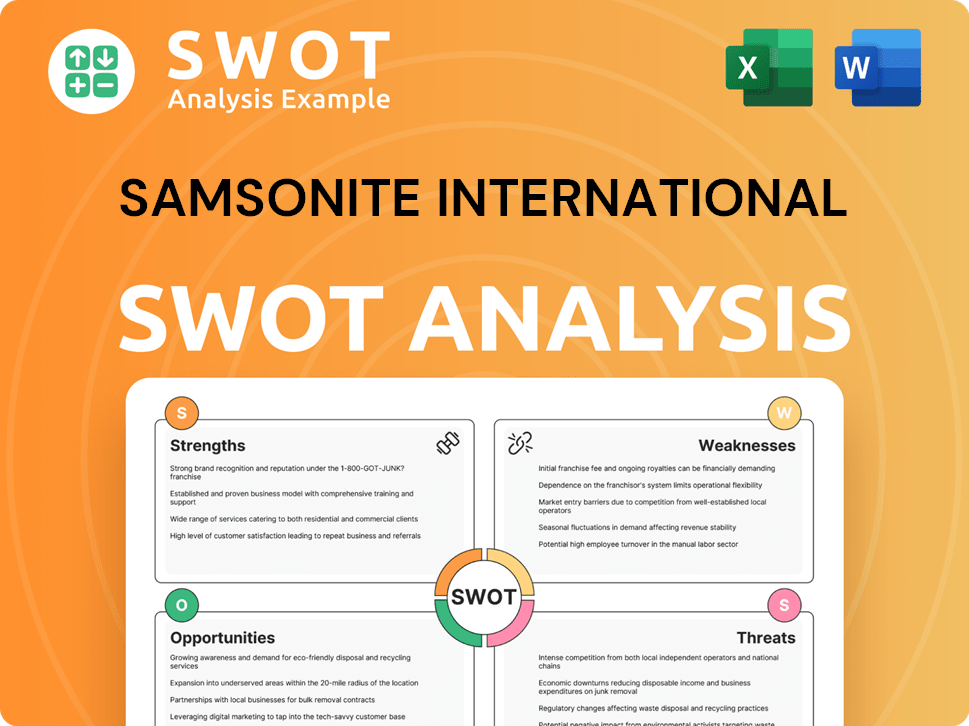
How Does Samsonite International Make Money?
Samsonite International generates revenue primarily through the sale of travel and lifestyle products. The company's revenue streams are categorized by product type and distribution channel, reflecting a diversified approach to sales and market penetration. This strategy allows Samsonite to reach a broad customer base and adapt to changing consumer preferences and market trends.
For the year ended December 31, 2024, consolidated net sales were US$3,588.6 million. The company's focus on multiple product categories and distribution channels highlights its resilience and adaptability within the travel industry. The company's financial performance demonstrates its ability to maintain strong sales figures and profitability.
The company's revenue streams are categorized by product type and distribution channel. In the fourth quarter of 2024, the core Samsonite, TUMI, and American Tourister brands together recorded net sales of US$882.3 million, a 2.4% year-over-year increase on a constant currency basis. The non-travel product category continues to be a growth area, accounting for 34.3% of net sales in 2024, up from 33.8% in 2023, and increasing by 2.0% year-over-year on a constant currency basis. In contrast, the travel product category accounted for 64.5% of net sales in Q4 2024.
Samsonite employs a multi-channel monetization strategy to maximize sales and customer reach. This approach includes direct-to-consumer (DTC) sales, third-party e-commerce platforms, and company-operated retail stores. The company's gross profit margin expanded to 60.0% for the year ended December 31, 2024, up from 59.3% in 2023.
- The direct-to-consumer (DTC) channel, which includes company-operated retail stores and e-commerce, contributed 39.8% of net sales in 2024, an increase of 90 basis points compared to 38.9% in 2023.
- DTC e-commerce net sales grew by 5.8% year-over-year in 2024, reaching $411.1 million, and accounted for 11.4% of total sales, up from 10.8% in 2023. Sales from company-operated retail stores also increased by 1.5% in 2024.
- The company also leverages third-party e-commerce platforms, with sales through platforms like Amazon accounting for 19.4% of total revenue in 2024, up from 18.2% in 2023.
- Understanding the target market of Samsonite International is crucial for its revenue generation strategies.
Samsonite International PESTLE Analysis
- Covers All 6 PESTLE Categories
- No Research Needed – Save Hours of Work
- Built by Experts, Trusted by Consultants
- Instant Download, Ready to Use
- 100% Editable, Fully Customizable
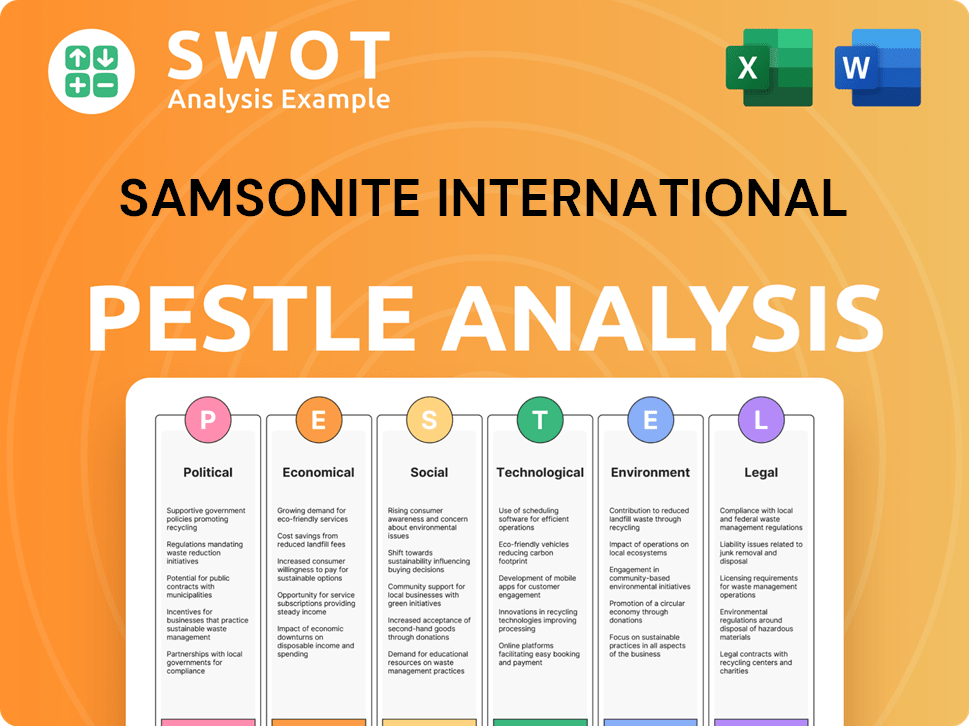
Which Strategic Decisions Have Shaped Samsonite International’s Business Model?
The evolution of the Samsonite business model has been marked by significant milestones, strategic shifts, and a focus on maintaining a competitive edge in the travel industry. These elements have been crucial in shaping the company's operations and financial performance. A key strategic move in January 2025 was the change of the company's corporate name from Samsonite International S.A. to Samsonite Group S.A., reflecting its transformation into a multi-brand entity.
This transition underscores the company's expansion beyond its flagship brand, incorporating brands like TUMI, Gregory, and Lipault. This diversification, coupled with the growth of the American Tourister brand since its 2011 IPO, has been central to its growth strategy. The company's commitment to its direct-to-consumer (DTC) business is evident in its retail expansion, adding a net of 67 company-operated retail stores during 2024, bringing its global retail network to 1,119 stores.
Operationally, Samsonite navigated challenges like softer consumer sentiment and increased competitive discounting in markets such as India and China in 2024. Despite these conditions, the company maintained pricing discipline and managed expenses, leading to improvements in gross profit margin and adjusted EBITDA margin in 2024. For a deeper understanding of the competitive landscape, consider exploring the Competitors Landscape of Samsonite International.
The company's name change to Samsonite Group S.A. in January 2025 highlights its evolution into a multi-brand entity. This strategic move reflects its growth beyond the original Samsonite brand. Expansion of retail network with a net addition of 67 stores in 2024, bringing the total to 1,119 stores globally.
Investment in the direct-to-consumer (DTC) business through retail expansion. Maintaining pricing discipline and expense control to improve margins despite market challenges. Consistent investment in marketing, around 7% of revenue, to maintain high brand visibility.
A strong brand portfolio, including the premium TUMI brand, allows for risk diversification and agility. Established global presence with over 1,000 directly operated stores and numerous multi-brand retail outlets. Commitment to sustainability, with approximately 40% of net sales in 2024 from products using recycled materials.
Continued investment in new products, brand elevation, and expansion of channel and product categories, particularly in the non-travel segment. Finalizing and publishing a new Human Rights Commitment in 2025. Adaptation to new trends and competitive threats through product innovation and market expansion.
Samsonite's competitive advantages stem from its diverse brand portfolio, global presence, and commitment to sustainability. The premium TUMI brand is expected to drive faster sales and margin growth. The company's extensive retail network and marketing investments bolster brand awareness and visibility.
- Strong brand portfolio, including TUMI.
- Extensive global retail network.
- Substantial investment in marketing.
- Economies of scale in supplier relationships.
- Commitment to sustainability.
Samsonite International Business Model Canvas
- Complete 9-Block Business Model Canvas
- Effortlessly Communicate Your Business Strategy
- Investor-Ready BMC Format
- 100% Editable and Customizable
- Clear and Structured Layout
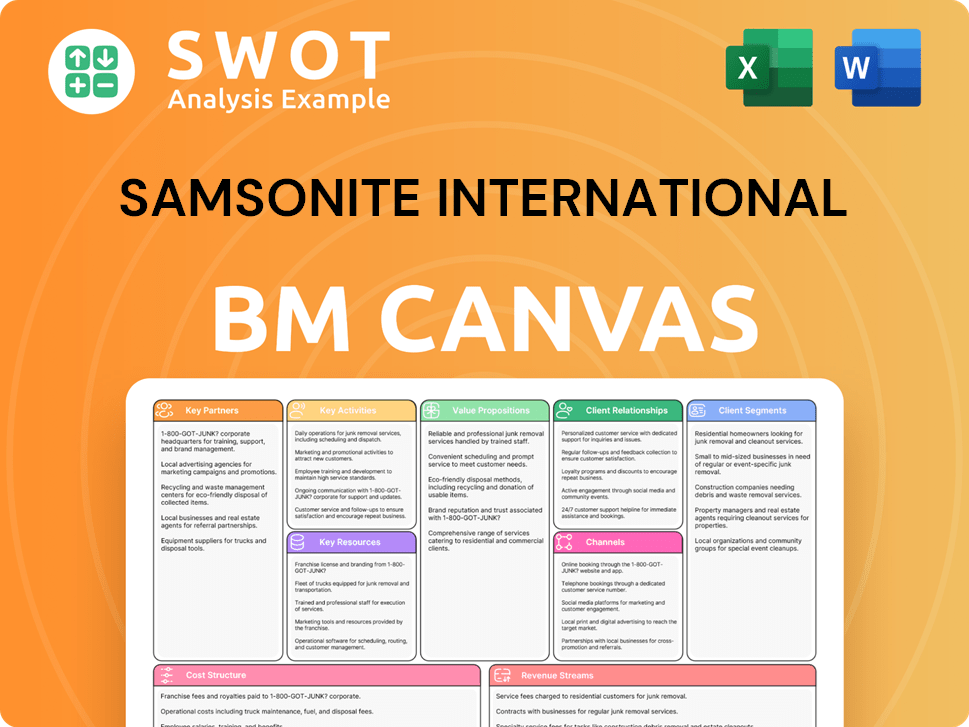
How Is Samsonite International Positioning Itself for Continued Success?
As a leading Luggage company, Samsonite International holds a prominent position in the global market. With a market share of approximately 25% in the global luggage industry as of 2024, the company leverages a multi-brand strategy to cater to diverse market segments. The company's extensive global reach, including 1,119 company-operated retail stores worldwide as of December 31, 2024, underscores its strong industry presence.
Samsonite's business model faces several risks and headwinds. Macroeconomic uncertainties, especially in North America, and potential tariff impacts pose challenges. A recession and weakened consumer spending in the US, which accounts for one-third of Samsonite's revenue, could negatively affect sales. Increased discounting by competitors in markets like India and China also create competitive pressures. These factors are crucial for understanding Samsonite's financial performance.
Samsonite is the world's largest travel luggage company. It has a significant market share, estimated at around 25% in 2024. The company's multi-brand approach, including Samsonite, TUMI, and American Tourister, helps it reach various customer segments.
Macroeconomic uncertainties, particularly in North America, pose a risk. Potential tariff impacts could also affect operations. Increased promotional activities by competitors in key markets create challenges. Weakened consumer spending in the US, which generates a substantial portion of revenue, is a concern.
Samsonite anticipates global tourism will grow steadily in 2025. The company is focused on expanding direct-to-consumer channels and enhancing product offerings. New product launches and store openings for Tumi and American Tourister are planned. The company is committed to sustainability, aiming to reduce emissions by 2030.
Focus on higher-margin brands, channels, and regions. Disciplined expense management to maintain margins. Investments in new products, brand elevation, and channel expansion. Targeted consumer-facing language on sustainability for core brands in 2025. Growth Strategy of Samsonite International will drive long-term growth.
Samsonite's adjusted free cash flow generation was US$311.0 million for the year ended December 31, 2024, providing flexibility for growth. The company aims to reduce Scope 3 emissions from purchased goods and services by 52% per unit of gross profit by 2030. The long-term financial performance is expected to be driven by the secular growth of global travel, with air travel demand projected to grow at an annual rate of 3.8% through 2043.
- Focus on higher-margin brands.
- Disciplined expense management.
- Investments in new products and brand elevation.
- Expansion of direct-to-consumer channels.
Samsonite International Porter's Five Forces Analysis
- Covers All 5 Competitive Forces in Detail
- Structured for Consultants, Students, and Founders
- 100% Editable in Microsoft Word & Excel
- Instant Digital Download – Use Immediately
- Compatible with Mac & PC – Fully Unlocked
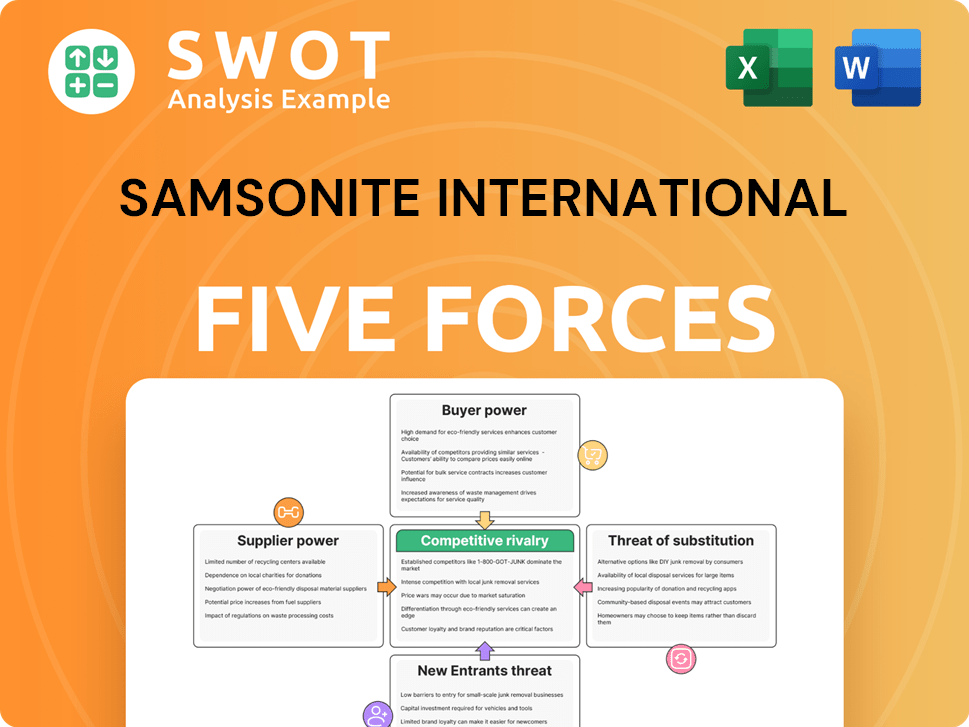
Related Blogs
- What are Mission Vision & Core Values of Samsonite International Company?
- What is Competitive Landscape of Samsonite International Company?
- What is Growth Strategy and Future Prospects of Samsonite International Company?
- What is Sales and Marketing Strategy of Samsonite International Company?
- What is Brief History of Samsonite International Company?
- Who Owns Samsonite International Company?
- What is Customer Demographics and Target Market of Samsonite International Company?
Disclaimer
All information, articles, and product details provided on this website are for general informational and educational purposes only. We do not claim any ownership over, nor do we intend to infringe upon, any trademarks, copyrights, logos, brand names, or other intellectual property mentioned or depicted on this site. Such intellectual property remains the property of its respective owners, and any references here are made solely for identification or informational purposes, without implying any affiliation, endorsement, or partnership.
We make no representations or warranties, express or implied, regarding the accuracy, completeness, or suitability of any content or products presented. Nothing on this website should be construed as legal, tax, investment, financial, medical, or other professional advice. In addition, no part of this site—including articles or product references—constitutes a solicitation, recommendation, endorsement, advertisement, or offer to buy or sell any securities, franchises, or other financial instruments, particularly in jurisdictions where such activity would be unlawful.
All content is of a general nature and may not address the specific circumstances of any individual or entity. It is not a substitute for professional advice or services. Any actions you take based on the information provided here are strictly at your own risk. You accept full responsibility for any decisions or outcomes arising from your use of this website and agree to release us from any liability in connection with your use of, or reliance upon, the content or products found herein.